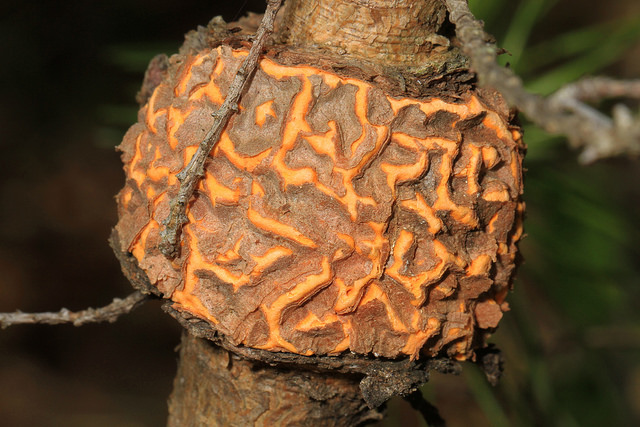This is the tenth part of a series on summer tree diseases. This article examines pine-oak gall rust, and pine-pine gall rust.
Introduction
During the summer months, plants are in the midst of their development. While many plants flourish due to the warmer climate, others can be subject to infections from a slew of disease pathogens. The following describes some of the most common diseases to affect plants in summer, and how they impact their hosts.
Pine-Oak Gall Rust (Cronartium quercum)
Pine-oak gall rust, also referred to as eastern gall rust, is a fungal disease that affects various pine and oak trees. The disease is native to North America. It is caused by the fungus, Cronartium quercum. The disease produces oblong to rounded galls on the stems or branches of infected trees. The galls increase in size each year, growing up to several inches in diameter. Fruiting structures develop on the galls, and rupture, covering the bark surface with a mass of powdery, orange-yellow spores. These spores are dispersed by air currents or splashes of rain to susceptible oaks, where they initiate new infections. Large galls can stunt plant growth, resulting in significant foliar dieback. Infections of the main stem often culminate in tree mortality.
Hosts
Pine-oak gall rust infects a variety of pines. Scots, Austrian, ponderosa, Jack, mugo, red, and Virginia pine are the most commonly infected. Alternate hosts include northern pin, bur, pin, and northern red oak. Red and black oaks are especially prone to infection.
Symptoms of Infection
Small galls may be visible after the first year of infection. The galls appear as round to oblong swellings along pine stems or branches. They are initially small, resembling peas. As the galls enlarge, they may reach up to the size of a pomegranate, or grapefruit. After the second year of infection, yellow-orange fruiting structures, referred to as aecia, will form on the surface of the gall. In spring, bright yellow to orange spores can be observed on this region of the gall. Bark collars occasionally form on either end of the gall, where the branch and gall intersect. Infected needles may turn yellow, and curl upwards. Infected branches and twigs may be stunted. Infected oak leaves usually develop chlorotic spots or blotches. Telia form on the underside of oak leaves.
Treatment
- When planting, avoid fields or landscapes adjacent to forest stands of oaks or pines that exhibit symptoms of infection. Select healthy plants that are resistant to the disease.
- Cull heavily infected trees to reduce the incidence of sporulation.
- Remove branches with galls prior to active sporulation in late spring.
- Registered fungicides can be used to prevent the infection of susceptible pines. To ensure success, applications must be performed in early spring, prior to sporulation.
- Maintain tree vigor through sound cultural practices. Ensure that trees are sufficiently watered, especially during extended periods of drought. Apply a layer of organic mulch around the base to improve soil quality, moderate soil temperature, and maintain soil moisture.
Pine-Pine Gall Rust (Endocronartium harknessii)
Pine-pine gall rust, also referred to as western gall rust, and Woodgate gall rust, is a fungal disease that infects two and three needle pine trees. It is caused by the fungus, Endocronartium harknessii. Pine-pine gall rust is similar to pine-oak gall rust, though it does not require an alternate host to complete its disease cycle. Instead, the fungus is spread between susceptible pine trees. Pine-pine gall rust can rapidly infect individual branches, or trees. Galls that develop on the main stem of a tree can severely disfigure, or kill the host.
Hosts
Scots pine and Jack pine are the two most common hosts. Many other pines, such as Austrian, ponderosa, lodgepole, western yellow, and mugo pine, have also been reported as hosts.
Symptoms of Infection
Pine-pine gall rust causes the formation of woody galls on the branches and stems of infected pines. The galls typically remain relatively small, resembling golfballs when mature. Some may grow as large as grapefruits, or pomegranates. New infections generally occur on vigorous shoots. Infections are difficult to detect for the first six months. The galls enlarge over two to four years, becoming increasingly spherical, or rounded. Galls can become large enough to girdle, and kill the infected branch. If a gall forms on the main stem, it will often disrupt the tree’s vascular system, preventing the distribution of water and nutrients throughout the crown. Numerous galls may form on an individual branch, causing it to develop a malformed appearance. One to two years after infection, small swelling growths may develop on infected branches. On heavily infected branches, needles may turn yellow, and then brown. Infected branches may die back prior to sporulation.
Treatment
- When galls are discovered on a landscape tree, excise the diseased branches. Pruning cuts should be administered in late winter or early spring, prior to sporulation.
- When pruning, remove dead branches from the tree to improve air circulation, and increase tree vigor.
- A registered fungicide may be applied to trees in early spring, before the galls produce spores.
- Maintain tree vigor through sound cultural practices. Ensure that trees are sufficiently watered, especially during extended periods of drought. Apply a layer of organic mulch around the base to improve soil quality, moderate soil temperature, and maintain soil moisture.
Photo courtesy of Judy Gallagher CC-by-2.0


